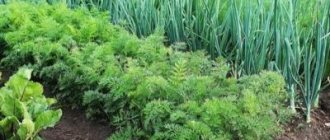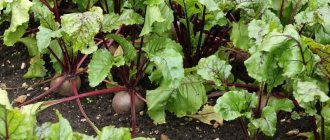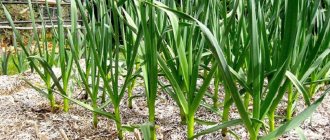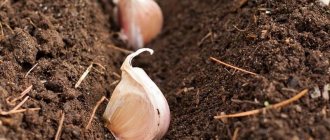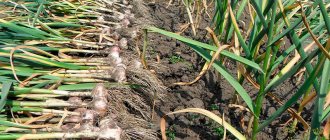To get a high-quality harvest of vegetables, it is necessary not only to plant correctly, but also to correctly select the previous crops and those that will grow in the neighborhood.
Dear readers! For you, we have created communities on social networks in which useful articles and interesting ideas are published several times a day! Subscribe and receive useful content in a convenient format!
Today we want to discuss crop rotation involving garlic. At the same time, we’ll find out after which the cloves can be planted in the fall.
What kind of soil does garlic like?
Crop rotation is an agrotechnical measure, the importance of which is difficult to overestimate. With its help you can increase crop yields. But if you plant vegetables in the wrong soil, all this will not matter.
After all, the plant will not be able to receive the required amount of nutrients.
Garlic is a vegetable that thrives in fertile soils. The plant prefers normal or slightly reduced acidity.
The ideal option for planting in autumn is sandy loam soil. Black soil or land with a high peat content is suitable. But we do not recommend planting on loams and alumina.
Spring garlic cultivation and care, including in open ground, as well as reasons for poor growth
When planting spring garlic in open ground in spring, you must follow certain rules:
- loosen the prepared soil in the fall;
- make shallow grooves with a distance between them of 20-25 cm.
Spring garlic cloves, prepared according to all the rules, should be placed in rows with the roots down and a distance between them of 7-8 cm. Cover the top with soil and lightly compact it. The layer of soil above the tops of the cloves should not exceed 2 cm.
If the soil is too dry when planting, it is advisable to water the beds with warm water. Cover the top with dry soil and do not water.
Is it possible to plant garlic after garlic?
There is a great temptation to plant garlic cloves in a familiar place every fall. Especially if the previous year was fruitful.
However, this cannot be done. It is extremely important to follow the basic principles and rules for the circulation of crops on the site. Garlic, for example, draws a lot of nutrients from the soil during its growing season. Especially potassium. You will lose in productivity, the plants will get sick more often and endure bad weather worse if you decide to constantly grow vegetables in the same bed.
Besides everything else, there is such a moment. Often during the summer season, plants become victims of diseases or pests. Even after the destruction of adult individuals, some pathogenic microorganisms and larvae may remain in the ground.
And when planting garlic in a permanent place, you yourself will create the most favorable conditions for infection of the plantings.
ON A NOTE. It is advisable to change the place where garlic cloves are planted every year, returning to the same place no more than once every four years.
Preparing teeth and planting
Now we’ll find out what kind of garlic material is used for winter planting. We can say that the most common subspecies of winter garlic is purple-striped. It is characterized by unpretentiousness and winter hardiness. Renewing it through air bulbs every three years, it will show record results.
We separate the garlic heads into cloves, as was written earlier, choose healthy and large ones. Pay special attention to the bottom of the cloves; if it becomes suberized, this can cause stunted plant growth. It’s good if you etch the teeth for 2-3 hours in a pink solution of potassium permanganate (0.1%), or copper sulfate (1 tablespoon per 10 liters of water).
Caring for material for spring planting of garlic begins in the same way as soil, in the fall:
- Dry the garlic heads thoroughly in a well-ventilated place;
- We store garlic only in heads, without separating into cloves;
- We comply with storage conditions.
You can reliably preserve garlic heads for planting, saving them from rot and drying out, in the following ways, popular among gardeners:
- wrap each head in “breathable” cling film;
- dip into melted slightly cooled paraffin;
- place in a box with onion peels or sawdust;
- braid it and hang it up.
In addition, the basic requirements for the room in which garlic will be stored for planting must be met:
- cool temperature;
- good air circulation.
A month before planting, it is advisable to subject the garlic heads to stratification, for which the planting material is placed in the ground at a temperature of 1... 3 °C.
Before planting, it is necessary to carry out the following agrotechnical measures:
- Calibration To do this, select the largest garlic cloves located in the first row of heads from the garlic cloves.
- Rejection. They get rid of teeth with obvious signs of disease, as well as degenerate ones. Degeneration is indicated by a small number of teeth in the head, as well as their doubleness.
It is not necessary to germinate planting material before planting, and if the planting time is too early, then due to possible frosts, the threat to the harvest is obvious. Sprouting cloves is advisable if the planting of the material is slightly late, or there is reason to accelerate the growth of the above-ground part of the garlic.
A day before planting spring garlic in open ground in spring, planting material should be brought into a warm room to warm up and activate growth processes.
You can also place the garlic in a warm, humid environment: wrap it in a cloth soaked in water or pour it into a container with a small amount of water. Be sure to place everything in a warm place, for example, on a radiator.
Interesting! Planting and caring for liatris in open ground
It is still advisable to soak high-quality teeth for 2-5 minutes:
- in a weak solution of potassium permanganate on the day of planting;
- in ash solution;
- in a solution of copper sulfate;
- in saline solution (1 tbsp per 1 liter of water).
If the quality of the seed is suspicious, then it should be soaked in a warm solution of one of the fungicides: Fundazol, Maxim, Fitosporin.
After disinfection measures, it is advisable to treat the seed material with growth stimulants, according to the instructions for use. For this purpose, you can use the effective preparations Zircon or Epin.
As we already remembered, winter garlic can be grown
(in a two-year cycle). You need to select large or medium-sized cloves for planting - you won’t get good garlic heads from small ones. Of course, the planting material must be healthy and not damaged. Even if the garlic is outwardly healthy, but it grew in an area infested with pests or diseases, you should refrain from planting it.
For planting, choose healthy large teeth. Photo by the author
I usually plant garlic without pre-treatment, but I read that it is advised to soak the cloves in a Fitosporin solution for 5-6 minutes and water the soil with the same solution before planting. I intend to try it this year: I have already been convinced of the undoubted benefits and effectiveness of the drug in practice, so I am inclined to trust this recommendation.
They are planted in prepared beds to a depth of 8-10 cm. It is recommended to mulch the soil with a layer of peat or humus. With the onset of persistent cold weather, I usually cover the beds with spruce branches or straw. The main purpose of such a shelter is to retain snow in the area where the garlic is planted.
After which you can plant garlic before winter
Now let’s discuss how you can then plant garlic in the fall without fear for the harvested garlic heads.
These are, first of all, representatives of the legume family. In Russia, peas and beans are most often grown.
The vegetable grows no less well where green manure and fodder crops were grown. For example, mustard, buckwheat, alfalfa, clover.
The exception is oats and barley. These are bad predecessors.
In the fall, you can safely plant garlic in those areas of your garden where you grew representatives of the pumpkin family in the summer. By and large, this applies, of course, to cucumbers. After all, squash, zucchini and pumpkins remain in the garden to ripen until autumn. But, if anything happens, you can plant them after them.
With the exception of cauliflower and early white cabbage, cabbage can be called a poor predecessor for garlic. But after the mentioned exceptions, planting in the fall is quite possible.
Recommendations for predecessors
Favorable predecessors of garlic are quickly ripening plants. They do not have time to take away all the useful substances and organic fertilizers applied to them. This organic matter will be used by garlic after them, especially since it is contraindicated for it in fresh form. So, for example, a pumpkin will not only leave its nutrition for it, but will also not transmit diseases, since they are different.
The best predecessors of garlic are legumes.
The bacteria contained in their roots produce nitrogen, which is an important fertilizer for garlic. The root system of legumes also loosens heavy soils, allowing the soil to be enriched with oxygen.
Berries such as currants, strawberries, strawberries can also be useful. You can be tolerant of places where medium-ripening crops grew.
Gardeners advise planting alfalfa, clover, and mustard in the garden where garlic is supposed to be planted in the fall. They will act as green manure, enrich the soil with useful microelements, and improve its structure.
Since the roots of garlic feed on substances from the surface layer, it should be planted after long-rooted plants that take components from deep layers of the earth, and in no case after root and tuber crops (potatoes, beets, onions, greens), which deplete the top layer. Moreover, they have the same diseases as garlic (fusarium, nematodes).
Herbs with a spicy smell have a depressing effect on the development of garlic and worsen its aroma.
Garlic compatibility table with specific crops
| Compatibility | Predecessors |
| The best |
|
| Possible |
|
| Not recommended |
|
After what crops should garlic not be planted?
Make a schedule for planting vegetables in the fall in advance so that the plants listed below do not grow in the beds in front of the garlic.
Bad predecessors are greens (for example, parsley, celery), parsnips, carrots, radishes.
Do not plant garlic cloves in the fall where herbs were grown.
IMPORTANT! To protect plants from nematodes, do not plant cloves after potatoes, sugar beets and rapeseed.
Experienced summer residents have noticed that representatives of the bulbous family grow very poorly in one area. Therefore, do not plant where different varieties of onions were sitting (shallots, chives, leeks, batun, etc.).
Of the flowering plants, bad predecessors for planting in autumn are narcissus and carnation.
Neutral cultures for garlic
Not every summer resident has a large vegetable garden, the size of which will allow any crop rotation scheme to be easily carried out.
For most, planting vegetables often becomes a compromise. After all, in a limited area it is necessary to grow a variety of, sometimes completely incompatible, neighbors.
Then there is nothing to do and it is allowed to plant after neutral predecessors.
In our case, these are eggplants, late varieties of white cabbage, corn, peppers, tomatoes, and beets.
ON A NOTE. They are also called “acceptable” predecessors.
Which neighbors are suitable for garlic?
Joint planting of vegetables is greatly underestimated by summer residents. Often, gardeners plant vegetables as needed. But some of them are better compatible and have a beneficial effect on the plants in the neighborhood.
For example, it is good to plant garlic in the fall next to future beds of beets, tomatoes, cucumbers, and carrots.
This proximity suits everyone because the garlic aroma repels some parasitic insects. Among them are pests such as weevils, carrot flies, aphids and mole crickets.
This representative of bulbous plants goes well with strawberries, calendula and horseradish. And also where you plan to grow cucumbers.
However, not all cultivated plants like such a neighbor. For example, parsnips, peas and beans should be planted further away.
What can you plant after garlic?
As we said above, it is advisable to plant the crop in a new place every summer season. This is due to the fact that the garlic bulb greatly depletes the soil during the growing season.
Therefore, the best option for the next year after cultivation is to plant green manure instead of garlic cloves. For example, mustard.
Firstly, it is a natural “green” fertilizer. Secondly, green manure suppresses weeds. Thirdly, they give the earth a rest.
If you do not have the opportunity to sow green manure, you can plant other vegetables. For example, tomatoes, peppers, eggplants, peas, cucumbers, pumpkin, zucchini, strawberries, beans.
Special conditions for growing garlic
It is not always possible to strictly adhere to all the rules. Therefore, there is an original way to “get out”. Experienced gardeners advise, as an option, immediately after harvesting the garlic to sow vetch in this area, after which (closer to the end of September) dig up the ground well, deepening the vetch into it, and then fertilize it with compost at the rate of a couple of buckets for each square meter of the area. It is also advisable to apply fertilizers rich in potassium and phosphorus. You can replace them with regular wood ash. Garden vetch, like all legumes, loosens the soil, saturating it with oxygen and moisture. In addition, it forms a large amount of nitrogen in the soil, while simultaneously disinfecting it from harmful microorganisms.
Is it possible to plant garlic and strawberries in the same bed?
There is no clear answer to this question.
Some gardeners claim that plants have a positive effect on each other, increasing yields and driving away pests.
Others say that there is no benefit in such a neighborhood.
However, this practice of joint planting in the fall exists. Let's look at the arguments for and against. Based on them, you yourself will draw a conclusion about the advisability of planting garlic cloves near strawberry rosettes.
The benefits and harms of garlic for strawberries
First, let's talk about the advantages of this neighborhood.
- Garlic phytoncides have a suppressive effect on pathogenic microorganisms, chafer larvae and other pests;
- Both crops require approximately the same feeding, which means the time spent on caring for plants is reduced.
Also among the advantages can be noted the saving of usable area of the summer cottage.
The following arguments are given against such a neighborhood:
- both plants often become victims of soil nematodes. Planting together will result in loss of yield from both crops.
- digging up garlic planted in the fall has a high chance of damaging the strawberry root system.
Common mistakes
- Crop rotation is observed, but the wrong soil is selected when planting in the fall.
- Crops are planted too close to each other. This causes competition for sunlight as well as minerals found in the soil. Moreover, plantings become thicker, which leads to the development of diseases.
- Crop rotation is not observed. In autumn, garlic is planted in place of bulbous crops or bad predecessors.
- The crop is grown in the same place for several years in a row or every other year. In order for the soil to restore its fertility, garlic can be planted no more than once every four years.
Why is it important to follow the rules of crop rotation?
Crop rotation is the alternation of different crops (vegetables, herbs) in the garden . This technology is an excellent assistant for growing tasty and healthy vegetables, berries, and herbs.
It is necessary to plant various crops according to crop rotation rules for several reasons:
- Proper alternation not only prevents soil depletion, but also saturates the soil with useful substances.
- Helps maintain the normal condition of the soil, helps it become healthier.
- Different crops consume nutrients in different volumes and from different layers of the soil (some from the lower, some from the upper), so proper rotation allows you to maintain the optimal amount of nutrients in the soil.
- Crop rotation prevents the accumulation of pathogens and pests.
- Improves the weed situation.
Thus, when choosing a bed with the right predecessors, you can save your resources and time, because you don’t have to waste energy on fertilizing and fertilizing, as well as treating against diseases and pests.
Below you can study the table of crop rotation of popular vegetable crops:
If you plant one crop in one place for several years, this can lead to unpleasant consequences: soil depletion, accumulation of pathogens, and pest invasion. But you need to change the crops in the beds wisely.
Video: features of crop rotation of vegetable crops
Answers to frequently asked questions
After what can I plant garlic in my garden without fear?
After legumes, squash and early ripening white cabbage.
Is there a difference where to plant garlic cloves in the garden in the fall?
Of course have. Plant on fertile soils (sandy loam, black soil). Make sure that groundwater does not lie too close to the surface. In this case, raise the bed.
Is garlic good for strawberries?
Many summer residents indicate that both plants have a beneficial effect on each other. And the phytoncides secreted by garlic drive away many pests from strawberries.
The best predecessors for garlic
Inexperienced gardeners, when growing garlic, do not take into account the rules of crop rotation. Usually this unpretentious culture is placed wherever there is free space. Often the aromatic vegetable is planted along the beds and between the rows. If the location or neighbors turn out to be unsuccessful, large heads will not be seen. When planning a planting scheme in your garden, you need to know after which crops you can plant garlic.
Cereals and green manures
If you plant winter garlic after cereals, the most favorable conditions for growth will be created for it. Cereal crops have rather long and strong roots, which prepare the soil for planting winter garlic. The above-ground parts of wheat, oats and other cereal plants serve as natural organic fertilizer.
It is recommended to sow areas that were cleared of predecessors early, sowing green manure crops. These include various grain crops (except barley and rye) and grasses. Green manure helps improve soil characteristics and saturates them with nitrogen.

